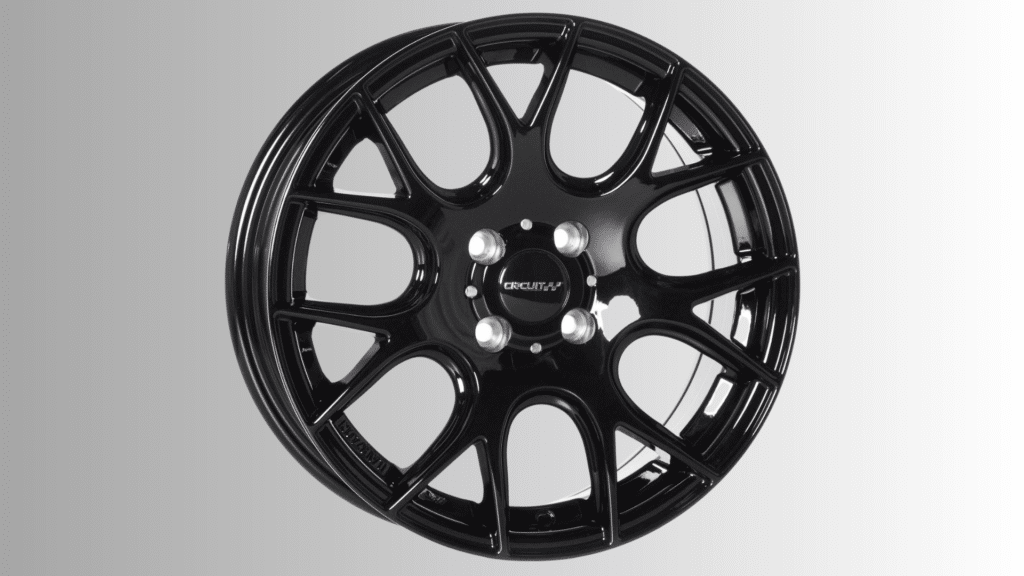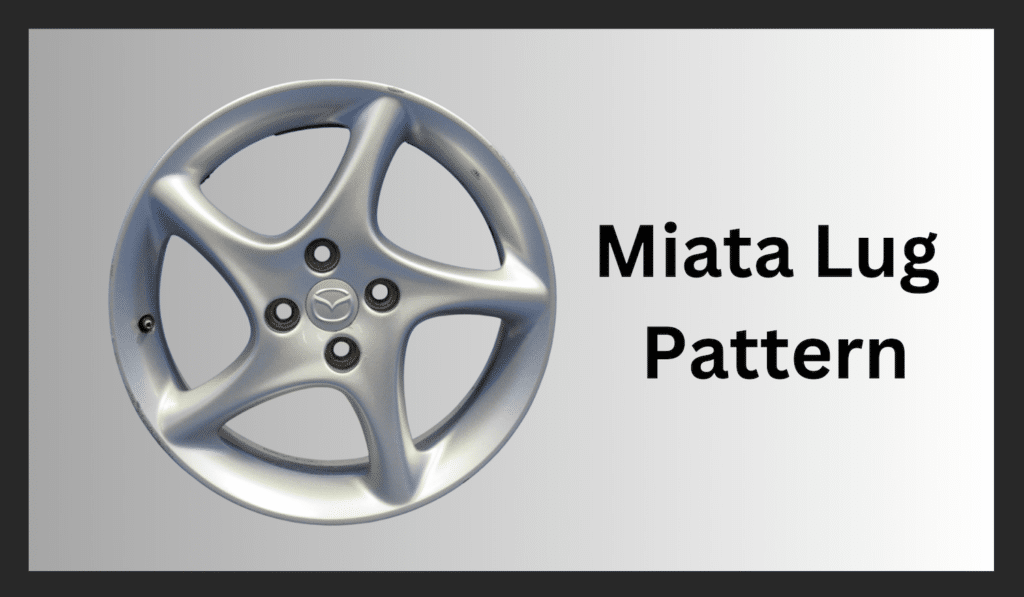Wheels play a crucial role in how a vehicle performs and looks. The Miata lug pattern is one of the key factors to consider when upgrading or replacing your wheels.
This pattern determines the arrangement of the bolts that hold the wheel to the hub. It affects how the wheels fit and how stable they are during driving.
Understanding the lug pattern helps ensure proper fitment and safety when deciding between stock specifications or exploring new options.
Knowing your Miata’s lug pattern allows you to find wheels that match your car’s style and provide a secure and comfortable ride.
In this guide, we’ll discuss the details of the Miata lug pattern, helping you make informed decisions for your vehicle.
What is the Lug Pattern for the Miata?

The Miata’s lug pattern refers to the number of bolt holes and the spacing between them. Most Miata models, including the popular NA and NB generations, have a 4×100 lug pattern.
This means each wheel is attached using four bolts spaced 100 millimeters apart.
This 4×100 pattern is common among small, lightweight cars, making it easier to find aftermarket wheel options that fit perfectly.
The consistency in lug patterns throughout various Miata generations simplifies wheel swaps and upgrades, ensuring that drivers can maintain proper alignment and stability.
When considering new wheels, confirming that they match the 4×100 pattern is essential to guarantee a secure and safe fit.
Understanding the Miata Lug Pattern and Its Compatibility
The Miata’s lug pattern is important in the car’s overall performance and safety. It refers to both the number of bolts that attach the wheel to the hub and the spacing between those bolts.
Over time, the Miata has featured two main lug patterns, and understanding these patterns can help owners choose wheels that fit properly without requiring extensive modifications.
Lug pattern compatibility ensures that the wheels sit securely on the hub, maintaining proper alignment and handling.
Using wheels with the correct pattern also reduces wear on components like suspension and brakes and helps maintain the car’s weight distribution.
Choosing the right lug pattern is not just about aesthetics—it’s about keeping your Miata safe and fun to drive.
List of the Correct Lug Pattern for Different Miata Models
Below are the correct lug patterns for each Miata generation:
1. NA Miata
The first-generation Miata features a 4×100 lug pattern. This means each wheel is secured with four bolts spaced 100 millimeters apart.
The 4×100 pattern is a common standard, making it easier for NA Miata owners to find aftermarket wheels.
It also provides the flexibility to swap wheels between NA and NB models without any compatibility issues.
2. NB Miata
The second-generation Miata retained the same 4×100 lug pattern as its predecessor.
This consistency allows NB Miata owners to benefit from the wide range of wheel options available.
Many drivers appreciate how simple it is to swap or upgrade their wheels without worrying about changing adapters or bolt patterns.
3. NC Miata
The third-generation Miata introduced a new lug pattern: 4×114.3. While it still uses four bolts, the spacing between them increased to 114.3 millimeters.
This change meant NC Miata owners needed wheels that matched this new pattern, as the earlier 4×100 wheels would no longer fit.
The shift to 4×114.3 opened up a different selection of aftermarket options, catering to the NC’s updated design and performance needs.
4. ND Miata
The current-generation Miata, the ND, continues the 4×114.3 lug pattern introduced by the NC.
By maintaining this larger bolt spacing, Mazda ensured that modern wheel designs and aftermarket offerings remained compatible.
This consistency across newer models makes it easier for ND owners to find wheels that fit securely while providing improved performance and aesthetics.
How to Identify the Correct Lug Pattern for a Specific Miata?
Identifying the correct lug pattern for your Miata is the first step toward ensuring that your new wheels will fit securely and perform properly.
By knowing your vehicle’s exact configuration, you can avoid costly mistakes and unnecessary modifications.
This guide will help you confirm the lug pattern so that you can confidently choose wheels that align with your Miata’s needs.
1. Count the bolt holes
Start by identifying how many bolt holes are on the wheel or hub of your Miata.
Most Miata models feature a four-lug configuration, which means there are four evenly spaced holes around the wheel’s center.
2. Understand the four-lug layout
Unlike some vehicles that use five or six lugs, the Miata’s design is straightforward.
Knowing that you’re working with four lugs ensures that you focus on the correct bolt circle diameter for accurate fitment.
3. Measure the bolt circle diameter
To determine the PCD, you need to measure the distance between the bolt holes. With a four-lug pattern, you can measure from the center of one bolt hole across the hub to the center of the hole directly opposite.
This measurement will tell you the exact spacing, which is essential for identifying compatibility.
4. Check the model-specific pattern
The NA and NB Miatas use a 4×100 pattern, meaning there are four bolt holes evenly spaced 100 millimeters apart. For NC and ND Miatas, the pattern changes to 4×114.3, meaning the bolt holes are spaced 114.3 millimeters apart.
Recognizing which generation you own allows you to select wheels with the proper pattern.
5. Confirm for a secure fit
After counting the bolts and measuring the PCD, you’ll have the exact lug pattern. This ensures that any wheels you purchase will fit securely, align properly, and provide safe, smooth performance.
Selecting the right pattern also prevents potential alignment issues or damage that can arise from using incompatible wheels.
By following these steps, you’ll have all the information you need to choose wheels that fit your Miata perfectly. Understanding your lug pattern is a straightforward process that guarantees a safer, smoother driving experience.
Comparisons Between the Miata and Other Cars’ Lug Patterns
The Miata’s lug pattern stands out for its simplicity and consistency across generations. While other vehicles often have five or even six lugs, most Miatas maintain a straightforward four-lug design.
This makes finding compatible wheels easier and often more affordable, as many aftermarket options cater to these standard four-lug configurations.
In contrast, cars with five-lug patterns, such as many sedans and sports cars, offer more structural support for heavier or more powerful vehicles.
The additional lugs help distribute the load more evenly and provide greater stability at higher speeds. However, these patterns can limit compatibility, requiring more specific wheel choices.
Compared to off-road vehicles or larger SUVs with six-lug patterns, the Miata’s smaller configuration is lighter and more suitable for its lightweight chassis.
While six-lug patterns are built for rugged terrain and heavier loads, the Miata’s design prioritizes nimbleness and reduced rotational mass.
This contributes to the car’s responsive handling and signature driving experience.
In short, the Miata’s lug pattern focuses on lightweight performance, while other vehicles’ lug patterns emphasize strength, load capacity, or high-speed stability.
How to Maintain the Lug Pattern on Your Miata?
Maintaining the lug pattern on your Miata is critical for safe, reliable performance. By checking torque, inspecting for wear, rotating tires, and keeping parts clean, you can ensure that your wheels remain securely attached and properly aligned.
- Check lug nut torque: Regularly verify that lug nuts are properly tightened to the manufacturer’s recommended settings. Over-tightening can damage threads, while under-tightening may cause wheels to loosen over time.
- Inspect lug holes for damage: Examine the lug holes for corrosion, cracks, or signs of deformation. Catching these issues early prevents further damage and ensures a consistent fit for the wheels.
- Rotate tires regularly: Rotating tires redistributes wear and reduces stress on individual lug holes, helping maintain the pattern’s integrity and prolonging wheel life.
- Clean wheel hubs and bolts: Dirt and debris can interfere with proper alignment. Keeping the hub and bolt surfaces clean ensures a flush fit and helps preserve the correct lug pattern.
By following these steps, you’ll protect the integrity of your Miata’s lug pattern, ensuring a secure connection and long-lasting performance.
Conclusion
Maintaining the lug pattern on your Miata ensures that your wheels remain securely attached, properly aligned, and safe to drive.
Regularly checking the lug nut torque, inspecting for any signs of damage, and rotating your tires help distribute wear evenly and prevent future problems.
Cleaning the wheel hubs and bolt surfaces also keeps the connection flush, reducing the risk of uneven mounting.
By taking these simple but essential steps, you preserve the integrity of your car’s lug pattern, prolong the life of your wheels, and ensure a smooth, reliable driving experience.
With consistent maintenance, your Miata’s lug pattern will remain in top condition, giving you the confidence to enjoy the road ahead without worry.
Frequently Asked Questions
What is the Miata’s lug pattern?
Most Miatas use a four-lug configuration. NA and NB models have a 4×100 pattern, while NC and ND models feature a 4×114.3 pattern.
How do I measure the bolt circle diameter?
On a four-lug wheel, measure from the center of one bolt hole to the center of the opposite hole to determine the bolt circle diameter.
Can I switch wheels between NA and NB Miatas?
Yes, since both the NA and NB Miatas share the 4×100 lug pattern, their wheels are generally interchangeable.
Do NC and ND Miatas use the same lug pattern?
Yes, both NC and ND Miatas have a 4×114.3 lug pattern, making their wheels compatible with one another.
How often should I check my lug nuts?
It’s a good idea to check the torque on your lug nuts periodically, especially after installing new wheels or after driving on rough terrain.


